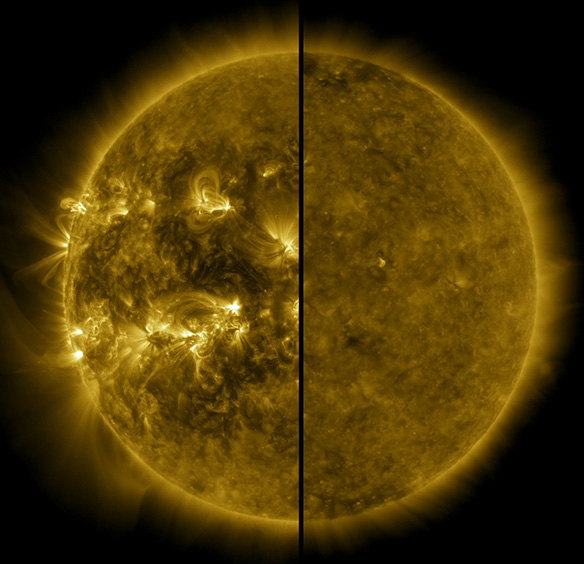In December 2019, a new solar cycle started. Solar cycles are the roughly 11-year periods—documented going back nearly 270 years—over which the Sun’s magnetic activity peaks and troughs. This activity is marked by the formation of sunspots on the Sun's surface. Sunspots occur where magnetic activity decreases convection from the Sun's ultra-hot interior, resulting in patches of lower surface temperature that appear darker than their solar surroundings. Based on various lines of contemporary evidence and historical patterns, most scientists think this current solar cycle (the 25th on record) will be a weak one, similar to the last four cycles, with a maximum sunspot number in the low 100s. Contrarily, other scientists predict that the maximum sunspot count will approach 260—among the highest on record. The latter group bases their bold prediction on evidence of the Sun having a more fundamental, 22-year magnetic cycle, of which the well-known 11-year sunspot cycles are merely a byproduct. If this prediction is borne out, our concept of solar cycles may need to be altered. See also: Heat convection; Mild space weather forecast for 2020s predicts few solar storms; Solar magnetic field; Sun

Accurately predicting solar cycles is important because sunspot numbers are strongly tied to the Sun's overall generation of "space weather." Like weather here on Earth, space weather can be inclement. Upticks in solar magnetic activity can trigger bursts of particles and radiation, known as solar flares, as well as coronal mass ejections, which involve a large release of solar plasma and magnetic field energy into space. Particles and energy from both phenomena can reach Earth and damage spacecraft, harm astronauts, and even pose hazards to infrastructure—such as power grids—on the ground. (Space weather is also connected to benign displays of the Northern and Southern lights.) See also: Aurora; Electric power generation; Radiation; Satellite (spacecraft)
A panel of experts recently convened by the U. S. National Aeronautics and Space Administration (NASA) and the U. S. National Oceanic and Atmospheric Administration (NOAA) predicted that the sunspot number during this current solar cycle—dubbed Solar Cycle 25—will peak at 115, which is close to Solar Cycle 24's recorded peak of 116 sunspots. The contrarian prediction of a peak of 260 sunspots comes from a team of astrophysicists based at the National Center for Atmospheric Research (NCAR). This team has long theorized about 22-year magnetic cycles experienced by the Sun, as evidenced by coronal bright points. These points are flickers of ultraviolet light in the corona, or outer atmosphere of the Sun. Coronal bright points move from the Sun's poles to its equator over the course of about 20 years. When bright points reach the Sun's mid-latitudes, sunspot generation usually commences, suggesting a strong connection between the two observables of bright points and sunspots. See also: Solar corona
The working theory is that coronal bright points are manifestations of magnetic bands that traverse the Sun from its poles to the equator. The bands tend to form every 11 years at the poles but sometimes slow their progression in the mid-latitudes and do not reach the equator at a consistent rate. When the bands—which are of opposite magnetic charge in each hemisphere—do eventually meet, they annihilate in an event called a terminator. By comparing the timing of terminator events and sunspot cycles over the history of modern solar observations, NCAR astrophysicists showed that the longer the time between terminator events, the weaker a subsequent solar cycle turned out to be, and vice versa for shorter terminator interims. The scientists think that longer interims provide more time for subsequently forming magnetic bands in their respective hemispheres to overlap and interfere with each other in the Sun's interior. The upshot: reduced sunspot production in the next solar cycle. Based on terminator patterns, NCAR scientists accordingly predict that Solar Cycle 25 will be a highly active—and, thus, potentially dangerous—cycle. Gaining a better understanding of solar cycles and having more accurate predictions of space weather to come can help operators and designers of spacecraft plan ahead; this information allows them to develop contingency plans in case of disabling solar emission as well as to build greater resiliency into the spacecraft. Likewise, electric grid operators can decide to allocate more resources to deal with the potential impacts of space weather, which would likely be most severe come mid-decade. See also: Magnetism





